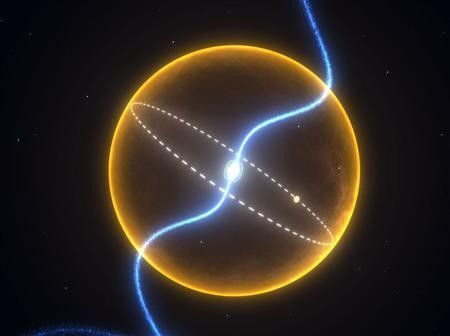Diamond Planet Spotted 4,000 Light Years Away [VIDEO]

A planet made entirely of diamond was newly discovered orbiting around a tiny star, lying around 4,000 light years away from Earth in the constellation Serpens.
A team of astronomers from Australia, Germany, Italy, the UK and the U.S. discovered the exotic diamond planet during their search for a pulsar, using the Parkes 64-meter radio telescope in western New South Wales.
The diamond planet is estimated as 34,175 miles across, which is about five times Earth's diameter.
As the planet largely consists of carbon, scientists speculate that the carbon within it has the right conditions to be crystallized, and believe it to be completely made of diamond. That would make it the universe's largest diamond of 1031 carats worth.
The giant celestial diamond has slightly more mass than Jupiter but is 20 times as dense. That is equivalent to 18 times the density of water, said Bailes.
The evolutionary history and amazing density of the planet all suggest it is comprised of carbon -- i.e., a massive diamond orbiting a neutron star every two hours in an orbit so tight it would fit inside our own Sun, said the lead author Professor Matthew Bailes of Swinburne University of Technology in Australia.
The team first detected an unusual pulsating star, called a pulsar, lying some 4,000 light years away, which is around an eighth of the way to the center of the Milky Way from Earth.
Pulsars are tiny, dead neutron stars that are only about 12 miles in diameter and spin hundreds of times a second, emitting beams of radiation.
They are formed when the core of a large star is compressed during a supernova and collapses into a neutron star. It then gives off radiation during a fixed period.
Though the new found pulsar is tiny and compact, measuring only about 12 miles across, it has a mass of 1.4 times that of the Sun and completes more than 10,000 rotations every single minute.
The pulsar's companion, the small diamond planet which obits the pulsar PSR J1719-1438, is believed to be denser than platinum, but made entirely of oxygen and carbon.
It was the irregular movements in the beams that clued scientists to the potential of a companion planet orbiting the pulsar, tipping them off to the existence of the diamond planet.
In this case, something with the mass of our sun has evolved to be something the mass of a planet -- quite extraordinary, astronomer Michael Keith of the Australia Telescope National Facility told Discovery News.
The system shows a stable operation, and shows no sign of change - possibly for billions of years.
Of course, this also means that it could well have been around for a long time, just waiting for us to find it. Since it's likely to last for longer than the Earth or the sun, I would say that in this case, a diamond really is forever, Keith said.
However, whether the long-living diamond planet shares the beauty of Earth's diamond remains a mystery.
In terms of what it would look like, I don't know I could even speculate, said Ben Stappers of the University of Manchester. I don't imagine that a picture of a very shiny object is what we're looking at here.
The research was published in the journal Science on Thursday.





















